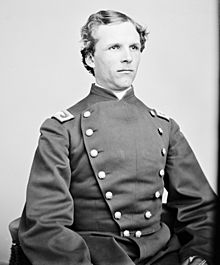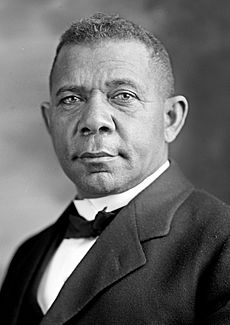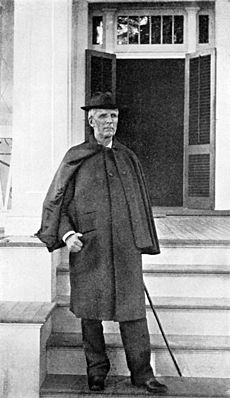Samuel C. Armstrong facts for kids
Quick facts for kids
Samuel Chapman Armstrong
|
|
|---|---|

Samuel C. Armstrong
|
|
| First President of Hampton Institute | |
| In office 1868–1893 |
|
| Preceded by | Incumbent |
| Succeeded by | Hollis B. Frisell |
| Personal details | |
| Born | January 30, 1839 Wailuku, Kingdom of Hawaiʻi |
| Died | May 11, 1893 (aged 54) Hampton Institute, Hampton, Virginia |
| Signature |  |
| Military service | |
| Allegiance | United States of America Union |
| Branch/service | Union Army |
| Years of service | 1862 - 1865 |
| Rank | |
| Unit | 125th New York Infantry Regiment 9th U.S. Colored Infantry Regiment |
| Commands | 8th U.S. Colored Infantry Regiment |
| Battles/wars | American Civil War |
Samuel Chapman Armstrong (January 30, 1839 – May 11, 1893) was an American soldier and general. He fought during the American Civil War. Later, he became a famous educator, especially for non-white students.
Samuel was born in Hawaii to missionary parents. He became a general in the Union Army during the Civil War. He led units of African American soldiers. After the war, he became well-known as an educator. He founded and became the first leader of a special school in Virginia. This school was for African American and later Native American students. It is now known as Hampton University. He also started the Hampton University Museum. This is the oldest African American museum in the United States. It is also the oldest museum in Virginia.
Contents
Samuel's Early Life and Family
Samuel Armstrong was born in Wailuku, Maui, in the Kingdom of Hawaiʻi. He was born on January 30, 1839. His parents, Richard and Clarissa Chapman Armstrong, were Christian missionaries. They were among the first missionaries to the Hawaiian Islands.
Samuel's father, Richard, was a minister. He also served as the Minister of Education for the Hawaiian Kingdom. He started schools across the kingdom. He believed in teaching students both academic subjects and useful manual trades. Students learned skills like blacksmithing and carpentry.
Samuel attended Punahou School in Honolulu for his early education. After his father died in 1860, Samuel, then 21, went to the United States. He studied at Williams College in Massachusetts and graduated in 1862.
Samuel married Emma Dean Walker in 1869. They had two daughters, Louise and Edith. Both daughters later taught at Hampton Institute. After Emma died in 1878, Samuel remarried in 1890 to Mary Alice Ford. She was also a teacher at Hampton Institute. They had a son, Daniel, and a daughter, Margaret. Daniel became a U.S. Naval officer. Margaret married a future president of Hampton Institute.
Samuel Armstrong in the Civil War
While Samuel was studying at Williams College, the American Civil War began. Samuel believed slavery should end. In August 1862, he joined the Union Army. He became a captain in the 125th New York Infantry.
Armstrong and his troops were part of the garrison at Harpers Ferry. They were surrendered to Confederate General Stonewall Jackson in September 1862. After being released, Captain Armstrong returned to Virginia. He fought at the Battle of Gettysburg in July 1863. He helped defend Cemetery Ridge against Pickett's Charge. He was promoted to Major after this battle.
In November 1863, Armstrong chose to lead African American troops. He became a Lieutenant Colonel in the 9th United States Colored Infantry. He started a school for these black soldiers. Most of them had no education because they had been slaves.
Later, Armstrong led the 8th U.S. Colored Troops. He led them during the Siege of Petersburg. His troops were among the first Union regiments to enter Petersburg. In November 1864, he was promoted to Colonel. This was for his brave service in battles near Petersburg.
After the war ended, Armstrong and his men were sent to Texas. They were discharged from the military in Philadelphia in November 1865. In 1866, President Andrew Johnson nominated Armstrong to be a brevet brigadier general. This promotion was confirmed by the U.S. Senate.
Samuel Armstrong: An Educator
After the war, General Armstrong joined the Freedmen's Bureau. This group helped formerly enslaved people. In 1868, he started the Hampton Normal and Agricultural Institute. It is now called Hampton University. It was located in Hampton, Virginia.
The Institute was a place for black students to get a post-secondary education. They could train to become teachers. They also learned useful job skills. Students could pay for their education by doing manual labor. This idea of combining learning with practical work came from his father's work in Hawaii.
During this time, many people believed that industrial training would help black Americans advance. After slavery ended, millions of black people in the South had no money or homes. Schools like Hampton helped them become independent. They learned skills to contribute to their communities.
Before the Civil War, many Southern states had laws against teaching slaves to read or write. After the war, these laws were removed. This showed how important it was to teach literacy. Hampton Institute helped address this problem.
General Armstrong believed that slavery had harmed the moral state of black people. He felt that white people needed to help them develop. He thought a "Hampton-style education" was the answer. This education combined learning, moral lessons, and manual training. He often said it trained "the head, the heart, and the hands."
Armstrong believed that black people should focus on education and work. He thought they needed to develop morally and religiously for several generations. He saw manual labor as a way to instill good values.
Hampton's main goal was to train future black teachers. Students had to plan to become teachers to be admitted. About 84% of Hampton's early graduates became teachers. Armstrong wanted these teachers to spread the idea of self-help and hard work.
One of Armstrong's most famous students was Booker T. Washington. Washington came to Hampton in 1872. He quickly adopted Armstrong's ideas. Washington later described Armstrong as a wonderful person. He said that just being around Armstrong was a great education.
Booker T. Washington later taught at Hampton. In 1881, Armstrong recommended Washington to lead a new school in Alabama. This school became Tuskegee University. Many groups and wealthy people were inspired by Armstrong and Washington's work. They helped create and fund schools for African Americans in the South.
Death and Lasting Impact
In 1892, Samuel Armstrong had a stroke. He returned to Hampton. He died at Hampton Institute on May 11, 1893, after a second stroke. He was buried in the student cemetery on Hampton's campus, as he wished.
His daughters continued to be involved with Hampton University. His son, Daniel, became a Naval officer. His grandson, Harold Howe II, became the Commissioner of Education.
Growth of Normal Schools
Over time, many new teachers went back to their communities. By the early 1900s, over 5,000 schools for black students were built in the South. People like Henry Huttleston Rogers, Andrew Carnegie, and Julius Rosenwald helped fund these schools. They often required local communities to also contribute. This made people feel they were helping themselves through their own hard work.
The "normal schools" like Hampton and Tuskegee changed over time. They started by focusing on job training and basic reading and writing. But they grew into places of higher education. They began teaching many different academic subjects. Many of these schools eventually became full universities.
Places Named After Samuel Armstrong
Several places were named after Samuel Armstrong:
- Armstrong High School in Richmond, Virginia, was named in his honor in 1909.
- Armstrong Manual Training School in Washington, D.C., was named for him in 1902. It is now Friendship Armstrong Academy.
- US Army Fort Armstrong, (Hawaii), built before World War I, guarded Honolulu harbor. Part of it is now a container terminal.
- A building and an award at Punahou School are named for him.
- Armstrong Hall (Science Building) at Tuskegee University was named after him in 1929.
Images for kids



